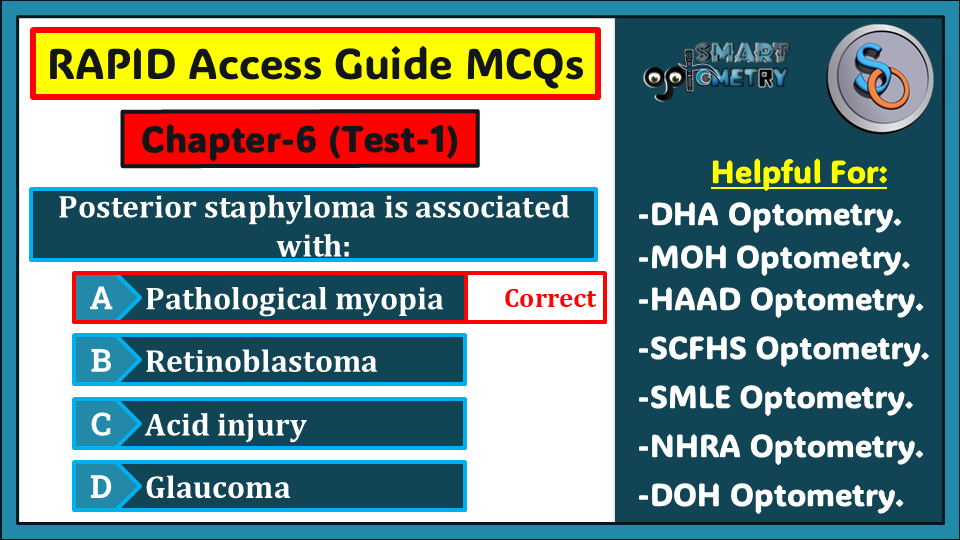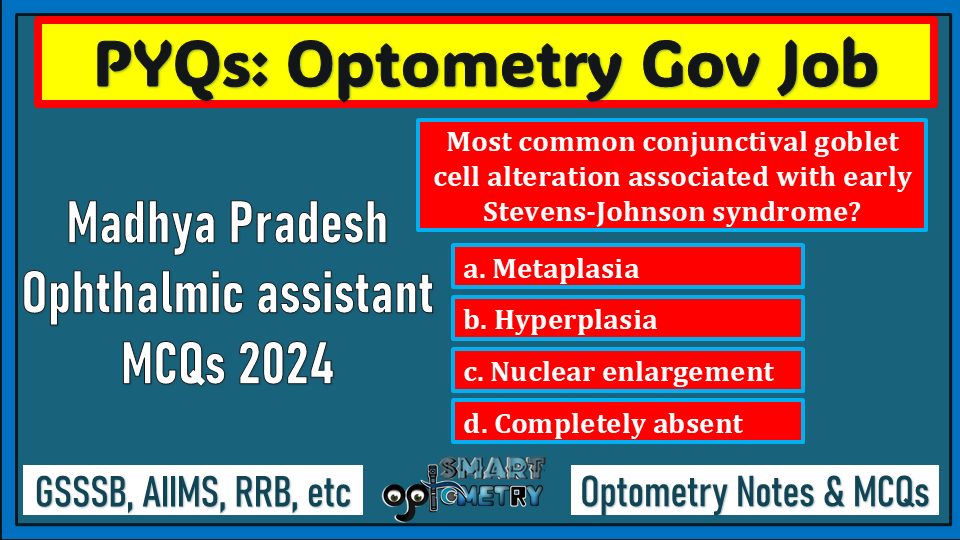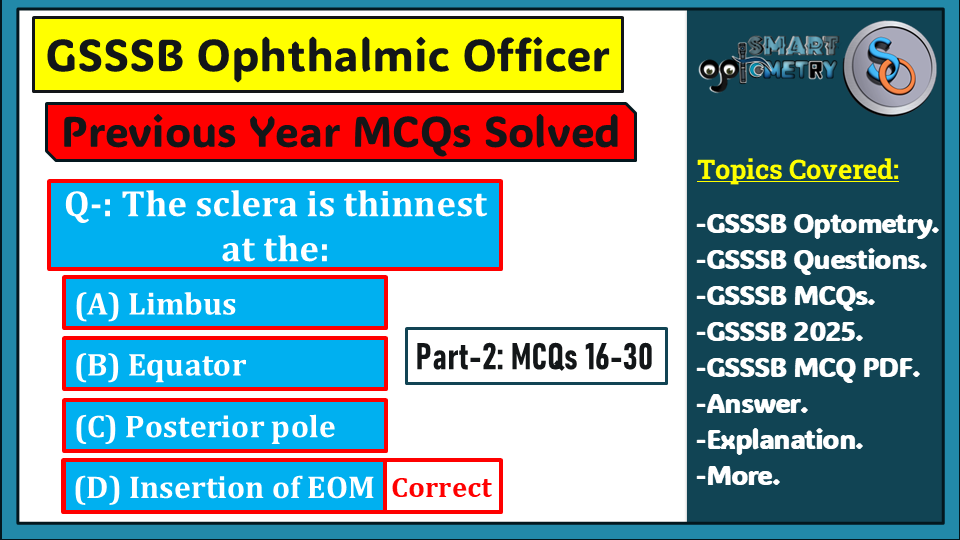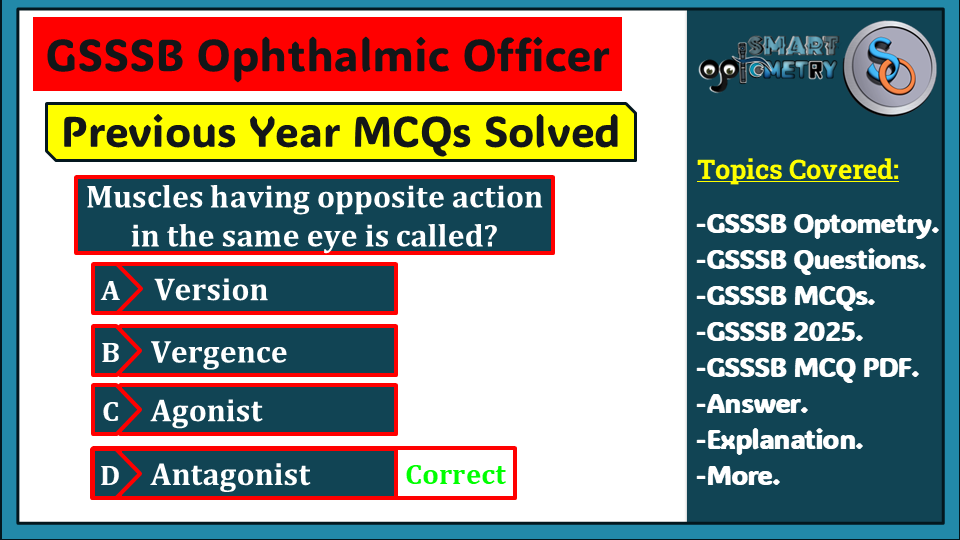1) The resting membrane potential of excitable cells is farthest from the equilibrium potential of which of the following ions?
- A. Sodium
- B. Potassium
- C. Chloride
- D. Calcium
Click “Show more” to see the answer and explanation.
Correct Answer: D.
Explanation:
The resting membrane potential of excitable cells is closest to potassium’s equilibrium potential (-90 mV) and farthest from calcium’s equilibrium potential (+120 mV). Calcium ions play a crucial role in action potentials but have minimal influence on resting membrane potential due to low intracellular concentration.
.
.
2) The following are true about prisms:
- A. They can control torsional diplopia
- B. They can control diplopia caused by an eye which is deviated out and up
- C. The prism power can be calculated from the refracting angle alone
- D. A prism with 1 diopter will produce a stronger deviation than one with an angle of apparent deviation of 10
Click “Show more” to see the answer and explanation.
Correct Answer: B.
Explanation:
Prisms are used to control diplopia in cases of horizontal and vertical misalignments. Torsional diplopia is not effectively managed with prisms, and both the refracting angle and the refractive index of the prism are needed to calculate the prism power.
Note: Our Course “MCQs in Optometry” with 95% success rate will help to prepare for Optometry License Exam like DHA, MOH, HAAD, QCHP, OMSB, SMLE, SCFHS, DHCC, NHRA.
.
.
3) Most of the axons that travel through the inferior cerebellar peduncles to the cerebellum originate from the:
- A. Pontine nuclei
- B. Red nuclei
- C. Vestibular nuclei
- D. Inferior olivary nuclei
Click “Show more” to see the answer and explanation.
Correct Answer: D.
Explanation:
Climbing fibers originating from the inferior olivary nuclei cross the midline and enter the cerebellum via the contralateral inferior cerebellar peduncle, playing a critical role in motor coordination.
.
.
4) Which is incorrect of papilledema?
- A. Sudden painless loss of vision
- B. Transient blurring of vision
- C. Disc edema
- D. Vascular engorgement
Click “Show more” to see the answer and explanation.
Correct Answer: A.
Explanation:
Papilledema is characterized by transient visual disturbances, optic disc swelling, and vascular engorgement, but it typically does not present with sudden vision loss unless there is severe or prolonged intracranial pressure.
.
.
5) Remnants of the pupillary membrane are incorporated into the:
- A. Major circle of the iris
- B. Anterior vascular tunic of the lens
- C. Iris collarette
- D. Trabecular meshwork
Click “Show more” to see the answer and explanation.
Correct Answer: C.
Explanation:
The remnants of the pupillary membrane, which typically regress after birth, are incorporated into the iris collarette, the thickest part of the iris.
Note: Prepare for your Optometry Licence/Academic Exam under experience Samir Sutradhar sir. Enroll in our Course “MCQs in Optometry” that will give you: Basic Notes, Fundamental Videos, Subjectwise MCQs, PDF MCQs, Previous Years MCQs, RAPID Access Guide for Optometrists PDF Book, Group Chat, Live Support.
.
.
6) Which of these structures is a neck root structure?
- A. Phrenic nerve
- B. Accessory cranial nerve
- C. Parathyroid gland
- D. Thyroid gland
.
.
7) A 50-year-old man presented with an orbital mass. Systemic examination revealed anemia, and investigations revealed hypergammaglobulinemia. The patient should be investigated to rule out:
- A. Squamous cell carcinoma
- B. Optic nerve glioma
- C. Multiple myeloma
- D. Malignant melanoma
.
.
8) An employee who works in a copper mine was found to have rod regeneration of more than 8 minutes on evaluation.
- A. Advise him to continue in the job due to more regeneration time
- B. Advise him to discontinue the job due to more regeneration time
- C. Advise him to shift to a new job
- D. Advise him to wear yellow-tinted lenses
Click “Show more” to see the answer and explanation.
Correct Answer: C.
Explanation:
Delayed rod regeneration time is a sign of impaired night vision, which can be dangerous in certain occupations like mining. Therefore, shifting to a safer job is recommended.
Note: Prepare for Optometry License Exam (DHA, MOH, HAAD, QCHP, OMSB, SMLE, SCFHS, DHCC, NHRA) with our course “MCQs in Optometry”. This course provides: Basic Notes, Fundamental Videos, Subjectwise MCQs, PDF MCQs, Previous Years MCQs, RAPID Access Guide for Optometrists PDF Book, Group Chat, Live Support.
.
.
9) Antigenic shift in influenza viruses is thought to be due to:
- A. Accumulation of point mutations
- B. Gene duplication and rearrangement
- C. Reassortment of viral RNA in a host cell infected by more than one strain of influenza virus
- D. Environmentally induced variations in viral gene expression
Click “Show more” to see the answer and explanation.
Correct Answer: C.
Explanation:
Antigenic shift occurs when two different strains of influenza infect the same host cell, leading to a reassortment of viral RNA and creating a new strain. This can lead to pandemics as the immune system has no prior exposure to the new strain.
.
.
10) The following are typical histological changes seen in benign hypertension:
- A. Fibrinoid necrosis of small arteries and arterioles
- B. Loss of endothelial cells of arterioles
- C. Hyalinization of the muscular media of the medium-sized arteries and arterioles
- D. Formation of new vessels
.
.
11) Which is the best method of manufacturing for making multiple complex designs on lenses?
- A. Cast molding
- B. Spin casting
- C. Lathe cutting
- D. Stabilized soft molding
Click “Show more” to see the answer and explanation.
Correct Answer: C.
Explanation:
Lathe cutting involves the use of a cutting tool, such as a diamond or laser, to precisely shape the lens. It allows for complex designs and custom curvatures.
Note: Enroll in our Course “MCQs in Optometry” to prepare for Optometry License Exam under Experienced Samir Sutradhar sir. This course will give you: Basic Notes, Fundamental Videos, Subjectwise MCQs, PDF MCQs, Previous Years MCQs, RAPID Access Guide for Optometrists PDF Book, Group Chat, Live Support.
.
.
12) Regarding interferon:
- A. It is a virus-specific molecule
- B. It acts by neutralizing exotoxin
- C. It enhances the histocompatibility antigen on the cell surface and thereby activates the T cells
- D. It exerts its effect by integrating itself with the DNA of virus-infected cells
.
.
13) In concave mirror retinoscopy, if the shadow moves in the same direction as the mirror, the refractive error is:
- A. Hypermetropia
- B. Myopia of 1D
- C. Myopia < 1D
- D. Myopia > 1D
.
.
14) The Schwann cell coat is lost as sensory nerves of the cornea pass through the:
- A. Limbal stroma
- B. Descemet’s membrane
- C. Corneal wing cells
- D. Basement membrane
Click “Show more” to see the answer and explanation.
Correct Answer: B.
Explanation:
As sensory nerves enter the corneal stroma from the limbus, they lose their myelin sheaths, and by the time they reach the Descemet’s membrane, they are only naked nerve endings.
Note: Our Course “MCQs in Optometry” with 95% success rate will help to prepare for Optometry License Exam like DHA, MOH, HAAD, QCHP, OMSB, SMLE, SCFHS, DHCC, NHRA.
.
.
15) The best immediate treatment for a chemical splash to the eye is:
- A. Neutralization of the chemical with an alkali
- B. Cold compresses
- C. Ocular lubricants
- D. Copious irrigation with water
.
.
16) If an area of 0.2 square meters receives a luminous flux of 40 lumens, the illuminance will equal:
- A. 400 lux
- B. 400 lumens
- C. 200 lux
- D. 200 lumens
.
.
17) Stereopsis approaches adult levels by about age:
- A. 6 months
- B. 3 months
- C. 1 year
- D. 9 years
Click “Show more” to see the answer and explanation.
Correct Answer: A.
Explanation:
Stereopsis, or depth perception, typically reaches adult levels by around 6 months of age as the visual cortex develops and the eyes start working together in unison.
Note: Prepare for your Optometry Licence/Academic Exam under experience Samir Sutradhar sir. Enroll in our Course “MCQs in Optometry” that will give you: Basic Notes, Fundamental Videos, Subjectwise MCQs, PDF MCQs, Previous Years MCQs, RAPID Access Guide for Optometrists PDF Book, Group Chat, Live Support.
.
.
18) Posterior staphyloma is associated with:
- A. Pathological myopia
- B. Retinoblastoma
- C. Acid injury
- D. Sympathetic ophthalmia
.
.
19) A patient presented with painful ophthalmoplegia. On CT scan, there was enlargement of the cavernous sinus on one side. The most likely diagnosis is:
- A. Cavernous sinus thrombosis
- B. Gradenigo’s syndrome
- C. Tolosa-Hunt syndrome
- D. Orbital pseudotumor
.
.
20) Frill’s excision is done in:
- A. Intraocular tumor
- B. Panophthalmitis
- C. Endophthalmitis
- D. Foreign body in the eye
Click “Show more” to see the answer and explanation.
Correct Answer: B.
Explanation:
Frill’s excision is a surgical procedure used in cases of panophthalmitis, a severe infection involving all layers of the eye. It is performed to control the spread of infection and prevent further complications.
Note: Prepare for Optometry License Exam (DHA, MOH, HAAD, QCHP, OMSB, SMLE, SCFHS, DHCC, NHRA) with our course “MCQs in Optometry”. This course provides: Basic Notes, Fundamental Videos, Subjectwise MCQs, PDF MCQs, Previous Years MCQs, RAPID Access Guide for Optometrists PDF Book, Group Chat, Live Support.
.
.
Conclusion:
Overview of “Rapid Access Guide for Optometrists”
The “Rapid Access Guide for Optometrists” is an essential resource designed for optometry students and professionals preparing for various optometry license exams, including DHA, MOH, HAAD, QCHP, OMSB, SMLE, SCFHS, DHCC, and NHRA. This comprehensive book provides a streamlined approach to mastering the content required for these certifications, offering practice materials, mock tests, and review questions tailored to the specific needs of optometrists.
Packed with Prometric Optometric Questions, this guide serves as a Prometric Exam Optometry Practice Question Bank, offering targeted preparation for DHA Optometrist Exam Questions, MOH Optometry Questions, and other Gulf-region exams. With resources like Optometry MCQ Book PDF Download, Optometry Rapid Review Guide, and Optometrist Exam Preparation Guide, this book ensures a complete learning experience for those aiming to excel in Free Optometry MCQs and Optometry License Exam MCQs.
The book also includes specialized tools such as HAAD Optometrist Questions Bank, NHRA Optometry License Questions, SCFHS Optometrist Study Material, and SMLE Optometry Questions Bank, ensuring relevance across a broad spectrum of regulatory bodies. For those seeking a DHA Mock Test for Optometrist or QCHP Optometrist Exam Guide PDF, this guide is your go-to preparation tool.
Key highlights include:
- Comprehensive Optometry MCQ Book with easy-to-understand explanations.
- Practice materials like MOH Optometry Exam Practice PDF and Gulf Countries Optometry License Prep Guide to simulate real exam scenarios.
- Resources for quick learning, including Rapid Review for Optometry Professionals and Optometry Quick Reference Book PDF.
- Tailored preparation tools like Prometric Optometrist Study Guide PDF and SCFHS Optometry Exam Prep Questions PDF.
- Access to free resources like DHA Optometry Exam Book Free PDF Download and Free Optometrist Exam Questions for additional practice.
Whether you are an optometry student or a seasoned professional, the “Rapid Access Guide for Optometrists” is a vital companion in achieving success in Gulf-region optometry licensing exams, ensuring you are fully equipped for your career journey.
- Check Our Courses: Ophthalmic Instrumentation, Clinical Refraction, Contact Lens, Binocular Vision, Dispensing Optics, MCQs in Optometry
- Download our App “Optometry Notes & MCQs” from Google Play Store.





